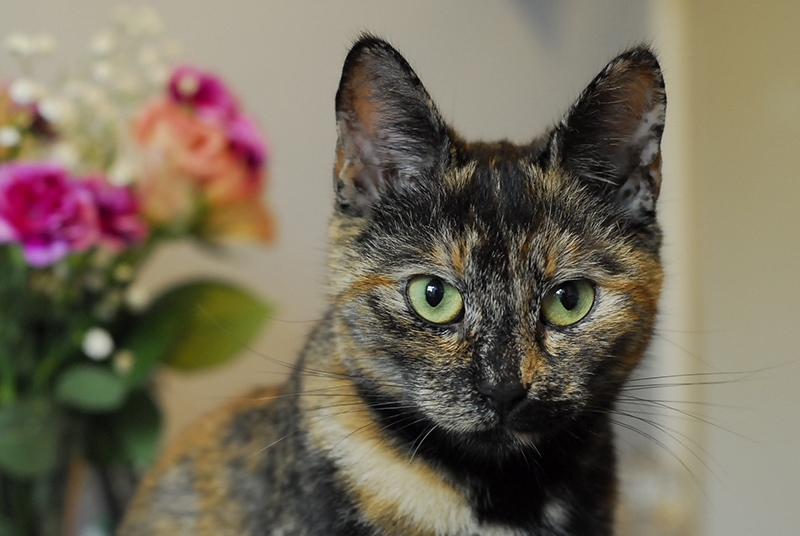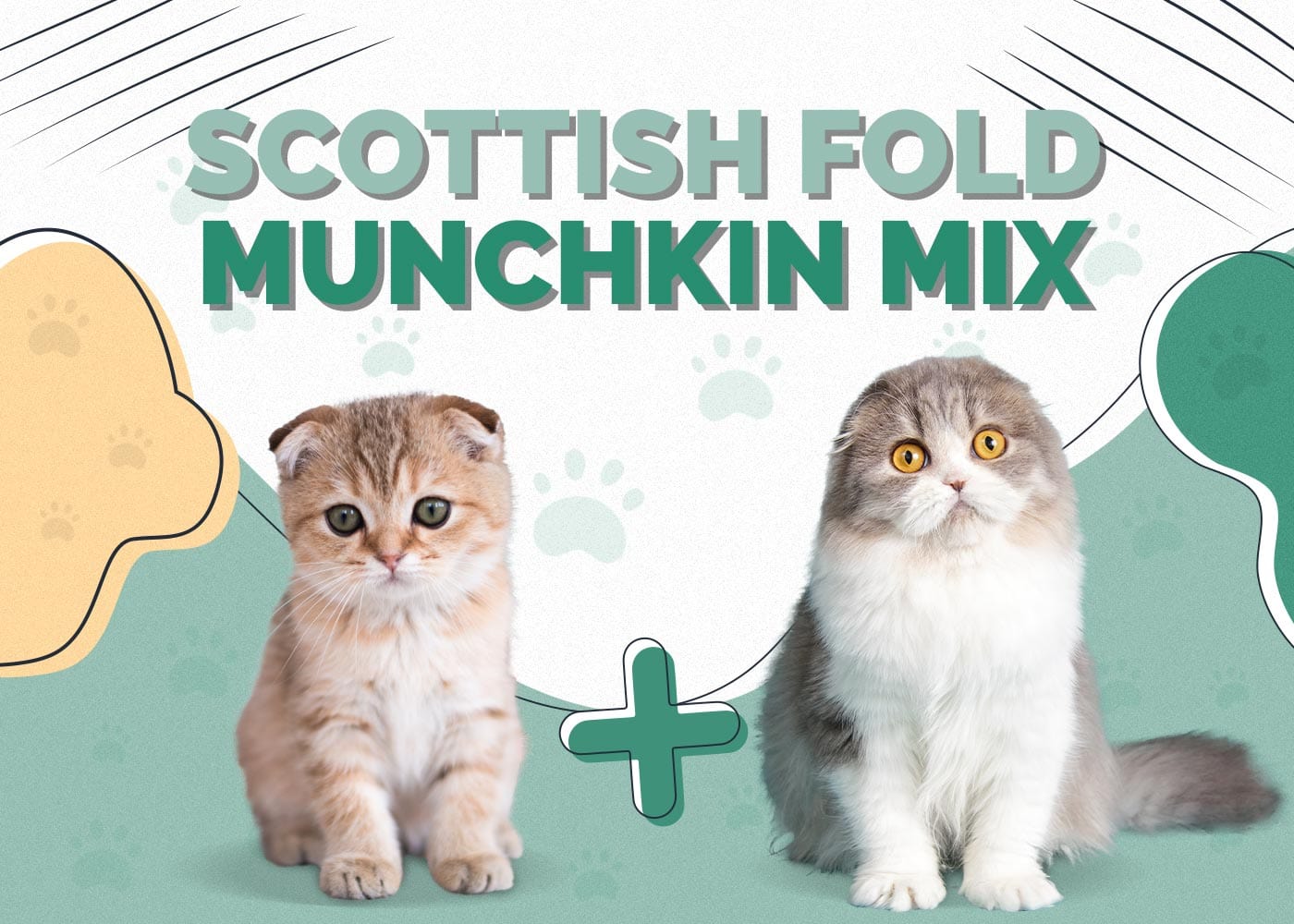Why Is My Cat Throwing Up Undigested Food? 7 Vet-Reviewed Reasons

Updated on
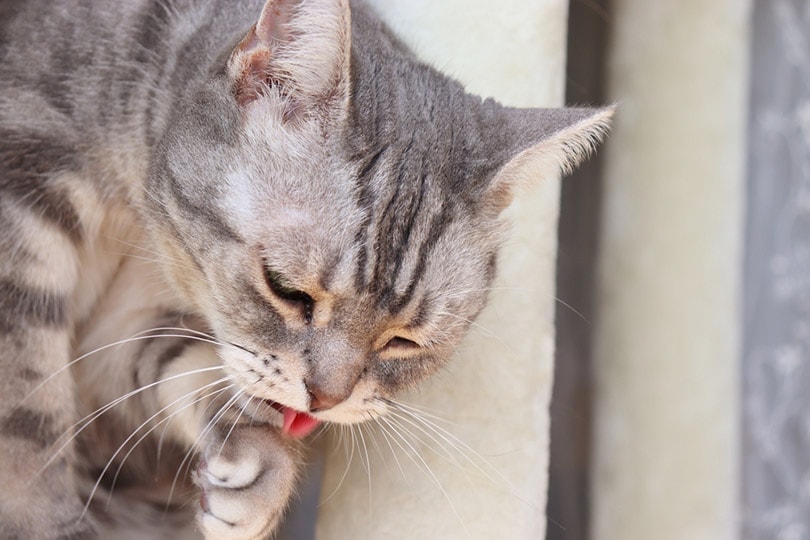
Click to Skip Ahead
Finding piles of thrown-up, undigested cat food can be unsettling for any cat owner. It is not unusual to wonder why your cat is suddenly throwing up undigested food. This is a common question among many cat owners.
Your cat may throw up due to many different underlying causes and should be addressed directly with your veterinarian. While vomiting is often a telltale sign of sickness and warrants a trip to the vet, there are times when a completely healthy cat may throw up undigested food. Although it is not uncommon for a healthy cat to throw up food once in a while, it is never normal for them to do so. Let’s take a further look into this below.
Vomit Versus Regurgitation
An important distinction to note is that food expelled from your cat’s mouth can be two different things: vomit or regurgitation. Understanding the difference between the two is key to determining the underlying cause of a cat’s dietary woes.
Vomit is the forceful ejection of food, or ingesta, from your cat’s mouth, which is an active process where your cat’s abdominal muscles will contract heavily and your cat will retch. In some literature, it may also be referred to as emesis. The expelled food is usually somewhat digested, meaning it does not necessarily look like what you fed your cat. It is often mixed with stomach contents and/or bile and may be a different color than your cat’s last meal. Cats can vomit at any time, and the vomit episodes need not immediately follow a meal.
Conversely, regurgitation is a passive action where a cat expels food from its mouth without signs of abdominal contractions or retching. The expelled food often looks almost exactly like what you have fed your cat, and these episodes typically happen immediately or very shortly after a meal.
To sum up the difference between the two:
| Vomit | Regurgitation |
| An active process of ejection | A passive process of ejection |
| Forceful contractions of the abdomen, retching | Very little to no force is involved |
| Contents look semi-digested and may contain stomach acids and bile | Contents look like food a cat recently ate |
| Can happen at any time, may or may not have a link with meal times | Almost always happens very shortly after meal time |
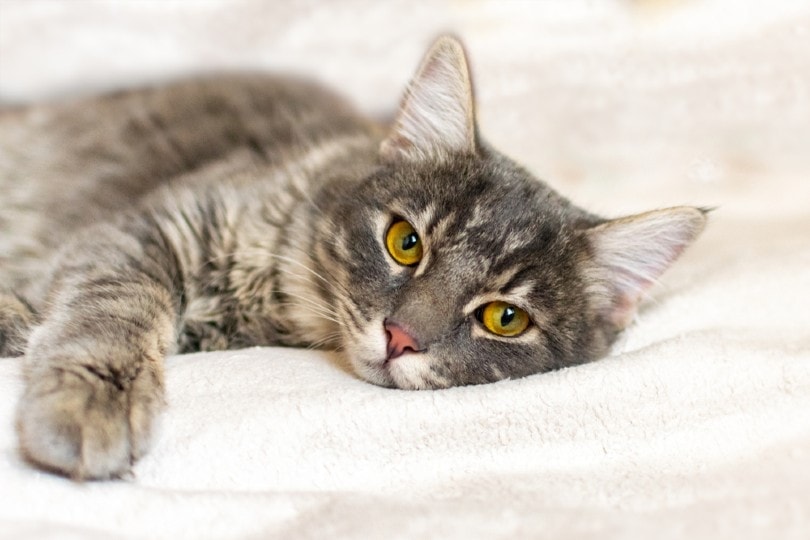
What to Expect from The Veterinarian
As mentioned above, whenever a cat is throwing up, it should be evaluated by a veterinarian first and foremost. The vet will complete a thorough physical exam, run necessary diagnostic tests, and go over your cat’s health history, eating habits, and environmental factors to help determine the cause.
Many different illnesses, both minor and more serious, can cause cats to vomit, which is why a veterinarian is needed to diagnose the underlying issue. Vomiting also results in fluid and electrolyte loss, which is why it requires medical attention. Some questions you can expect to be asked by your veterinarian include:
- How long has your cat been ‘vomiting’?
- When was the last time your cat had a ‘vomit’ episode?
- Was the ‘vomiting’ episode right after a meal?
- Did your cat look like it was in pain when it was ‘vomiting,’ or did it look surprisingly normal as the food came out?
- Did the ‘vomit’ smell weird in any way?
- When was your cat last dewormed?
- Does your cat have access to trash bins or your laundry room?
- Have you recently cleaned your house with a detergent?
- Does your cat groom itself a lot?
- Have you changed your cat’s food recently?
- Has your cat begun taking any over-the-counter or prescribed medication?
- What kind of diet do you feed your cat?
- What supplements do you give your cat?
- Do you apply any topical supplements/creams/ointments, etc. onto your cat?
- Is your cat an indoor or outdoor cat?
- Do you have other cats in the house, and if so, are they also throwing up?
- How often is your cat ‘vomiting,’ and what does the ‘vomit’ look like?
- How often is your cat vomiting, and what does the vomit look like?
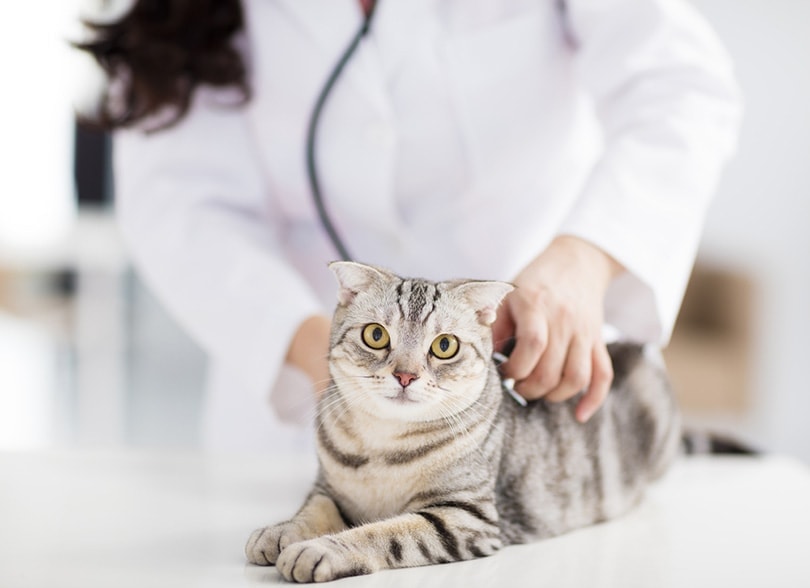
What Does It Mean When My Cat Throws Up Undigested Food?
If your veterinarian has ruled out any illness and has determined your cat is healthy overall, your cat may just be scarfing his or her food too fast for its good. Some cats will eat too much, too fast, and hardly even chew. They are simply eating faster than their body can handle, causing them to vomit within a few minutes of their meal.
Hairballs, food allergies, foreign body obstruction, or a condition affecting the esophagus in the digestive tract that prevents the food from moving into the small intestine are other more common reasons that food may be thrown up. Therefore, a visit to the vet is very important if your cat begins throwing up undigested food.
Should I Be Concerned About My Cat Throwing Up?
Seeing your precious kitty vomit will likely cause you some concern, but there is no need to panic. While there could be a more serious underlying issue, it could be as simple as your cat eating too fast. It is important to remember that throwing up is never normal for a cat. However, rare episodes of throwing up that occur once a month or every other month (or even less frequently) are of less concern than episodes that happen more often.
That being said, hairballs, foreign body obstruction, food allergies, toxin ingestion (like of certain houseplants), or any other underlying causes will need to be ruled out by your veterinarian. Foreign body obstruction can be fatal if left untreated and food allergies need to be assessed and handled accordingly. Therefore, a visit to the vet is so important if your cat begins throwing up undigested food.
If your vet has completed a thorough physical examination and tested for any underlying issues and has determined your cat is healthy, there should be no cause for concern. Some cats simply gobble down their food much too quickly, causing them to regurgitate.

How Do I Get My Cat to Stop Throwing Up Food?
If the vet has ruled out any underlying health issues and determined your cat is eating too fast, it’s time to look into the potential causes for their eating speed and how to slow them down. Thankfully, there are some tips and tricks you can try to prevent them from scarfing and barfing their food. After all, no one wants piles of undigested cat vomit around their house. Not only is the cleanup no fun, but no one also wants to accidentally step in it. Ew!
If you're tired of all the smells and stains that come with pet parenting, you should check out the Hepper Advanced Bio-Enzyme Pet Stain & Odor Eliminator Spray. Okay, it's our product, so we may be biased – but we love it so much, we just have to share it! It permanently removes even the very worst smells and stains, and we offer a 100% satisfaction guarantee.
- ADVANCED ENZYMATIC CLEANER - Penetrates the most stubborn smells and stains at the deepest molecular...
- FOR ANY MESS, ON ANY SURFACE - This pet odor eliminator cleans your carpets, floors, furniture,...
The 7 Reasons Cats Eat Too Fast
1. Territorial Instincts
If you have a multiple cat household or even if you have one cat but have dogs or other animals, their eating speed may be related to territorial behavior. Their instincts can still play a role in a domesticated situation, your cat may feel like they need to hurry up and eat as quickly as possible to avoid having it stolen by other animals in the home.
There are many situations where the alpha cat of the family (or even the hungry dog) will hoard all food so any others may need to hurry up and eat before they do not have a chance. A great way to prevent this is to feed them separately to make them feel more secure, whether it be in another room or even a kennel. Cats are also opportunistic feeders. Predators in the wild don’t eat at regular intervals or on a schedule and are accustomed to overfeeding and eating quickly whenever they have the opportunity. This instinct is hard-wired in our feline friends as well.
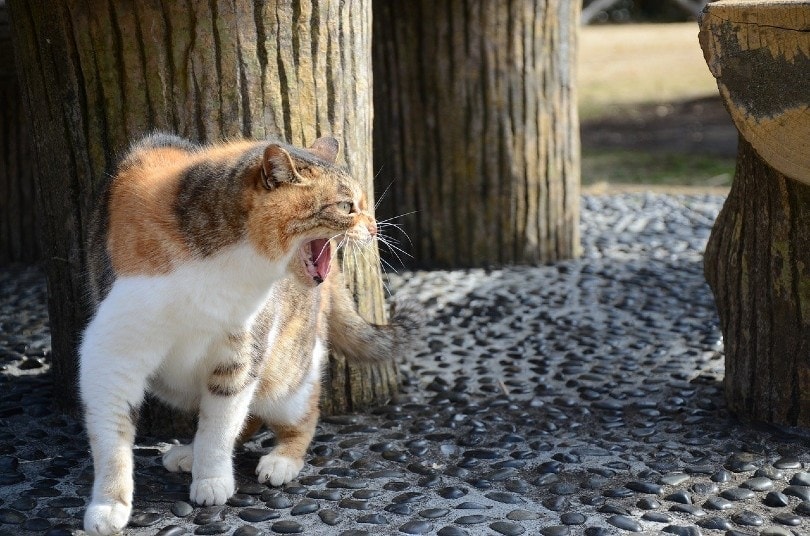
2. Behavioral Problems
Behavioral issues could be the root of this cause. Not unlike humans, cats can also eat out of boredom, stress, and even loneliness. When you speak to your veterinarian about the vomiting issue, make sure to mention any unusual behaviors you have noticed or any recent life changes that could potentially be caused by stress. Cats can be very sensitive to their environment, and if behavioral issues are determined to be the root cause, your veterinarian can work with you to help resolve the issue. Cats should not have access to food at all times, as this may result in them eating purely out of boredom.
3. Underlying Medical Condition
Certain medical conditions, such as diabetes and hyperthyroidism, can cause an increase in appetite that can even make them seem insatiable. If quickly scarfing down food is unusual for your cat and you have suddenly started noticing this, it’s time to head to the vet for a proper diagnosis

4. Past Trauma or Neglect
If your cat was rescued from an abusive or neglectful situation, it’s not uncommon for these kitties that have suffered prior trauma to overeat and eat very quickly. They may not have had regular access to food in the past, causing them to be a bit overzealous when it’s feeding time. Hunger as a result of neglect or abuse can condition cats to eat quickly.
5. Lack of Proper Nutrition
Cats need to be fed a high-quality diet that is appropriate to their size, age, and activity levels. If they’re fed a low-quality diet or are not getting the right amount of food, they are likely being deprived of important nutrients, leading to an increase in hunger. They may eat much faster during subsequent meals because of their hunger drive. It is therefore important to feed your cat a diet that is appropriate and adequate in a suitable environment.
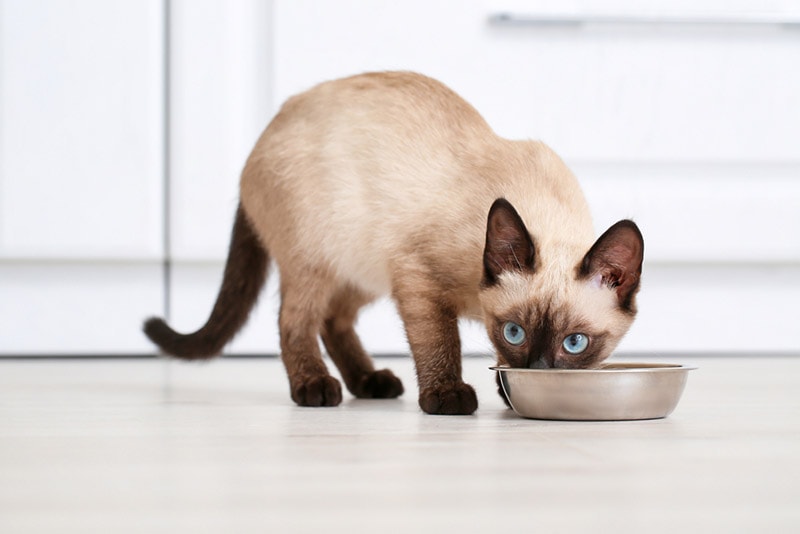
6. Parasites
Many intestinal parasites, such as tapeworms, will attach themselves to the intestines and steal all the nutrients from the food your cat is consuming. This results in your cat not getting the proper nutrients they need for themselves, which can cause an increase in appetite. Additionally, heavy worm burdens can limit the space in your cat’s intestines or cause irritation to the intestine, which may lead to your cat vomiting. Cats may, on occasion, vomit up worms as well. It is important to rule out parasites with your veterinarian and get any needed deworming completed, as this can result in malnutrition and anemia.
7. They Like the Way it Tastes
The simplest and more comforting reasons your cat is eating so quickly could simply be because they enjoy the taste of the food and feel the need to scarf it down as quickly as possible. If this is the case, there are some tips and tricks to help slow them down.
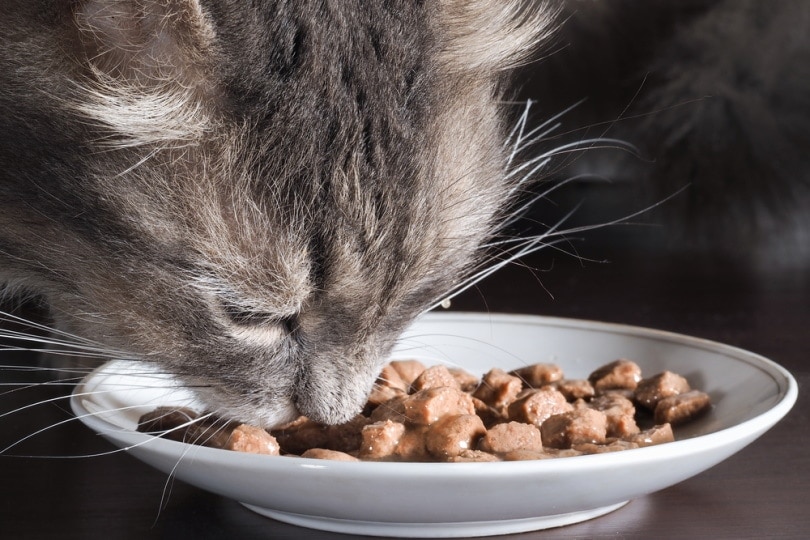
The 4 Tips for Slowing Down Eating
1. Feed Smaller Meals More Frequently
Feeding your cat smaller, more frequent meals can help prevent overindulgence. While it is convenient to just put the needed amount of food in a dish twice a day, it may be beneficial for a cat to eat smaller amounts. Since they do require a certain amount of food each day, you will have to split the needed quantity up into several feeding throughout the day. The downside is that this can be more difficult if you do not have the time or there is no one home during the day. This can be circumvented to an extent by using automated feeders that dispense a small portion of food at regular intervals. These feeders can also allow you to interact with your cat while you’re out of the house, as there are models that come with built-in webcams and mics.
2. Spread the Food Out
Another option is to put the food dish aside and opt for a large plate or even a large pan with raised sides. Spreading their food across a larger surface will prevent them from taking large mouthfuls at once. Raised sides will cause them to work harder to reach their food and will prevent unwanted messes on the floor. This can even be done with canned food!
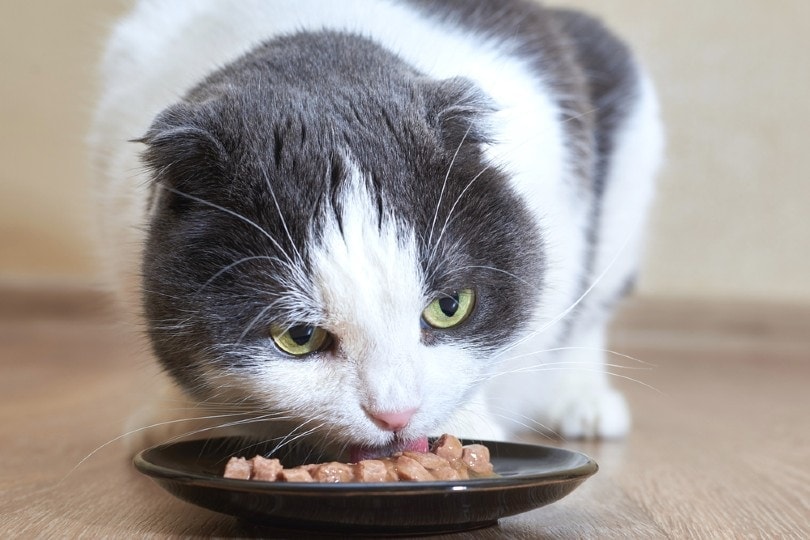
3. Feeding Obstacles
Putting obstacles in the bowl will require your cat to have to maneuver around the object to get to the food, which naturally slows them down. This is best done by using a slow feed dish. Many cat food dishes on the market have built-in feeding obstacles for this reason. You can check out your local pet store or hop online and see the different options.
4. Food-Dispensing Toys
If the slow feed dishes are of no interest or are not doing the trick, you can look into food dispensing toys. There is certainly no shortage of these toys available, and while they are generally meant as a fun activity that provides mental stimulation with rewards, they can also work wonders to slow down food consumption and provide your cat with some exercise. These toys will likely work best for younger and more playful cats. While you may have to coax a lazier cat into using such a toy, it is often worth it, as the additional exercise can provide health benefits for obese cats. Cats are naturally inquisitive, and once coaxed, often snap out of their laziness.
Conclusion
Your cat could be throwing up undigested food for a variety of reasons. It is important to have your cat seen by their veterinarian if they suddenly begin throwing up or exhibiting any unusual symptoms, as early treatment and diagnosis are best.
While throwing up can indicate underlying health conditions such as disease, allergies, or even foreign object obstruction, the cause could also be as simple as your cat eating too quickly for its body to handle. There are easy things you can do at home to slow down kitties who eat too quickly, as shown in this article. Other causes and concerns will require veterinary evaluation and care.
Featured Image Credit: chie hidaka, Shutterstock




